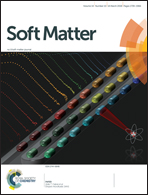Fabrication of tough epoxy with shape memory effects by UV-assisted direct-ink write printing†
Abstract
3D printing of epoxy-based shape memory polymers with high mechanical strength, excellent thermal stability and chemical resistance is highly desirable for practical applications. However, thermally cured epoxy in general is difficult to print directly. There have been limited numbers of successes in printing epoxy but they suffer from relatively poor mechanical properties. Here, we present an ultraviolet (UV)-assisted 3D printing of thermally cured epoxy composites with high tensile toughness via a two-stage curing approach. The ink containing UV curable resin and epoxy oligomer is used for UV-assisted direct-ink write (DIW)-based 3D printing followed by thermal curing of the part containing the epoxy oligomer. The UV curable resin forms a network by photo polymerization after the 1st stage of UV curing, which can maintain the printed architecture at an elevated temperature. The 2nd stage thermal curing of the epoxy oligomer yields an interpenetrating polymer network (IPN) composite with highly enhanced mechanical properties. It is found that the printed IPN epoxy composites enabled by the two-stage curing show isotropic mechanical properties and high tensile toughness. We demonstrated that the 3D-printed high-toughness epoxy composites show good shape memory properties. This UV-assisted DIW 3D printing via a two-stage curing method can broaden the application of 3D printing to fabricate thermoset materials with enhanced tensile toughness and tunable properties for high-performance and functional applications.



 Please wait while we load your content...
Please wait while we load your content...